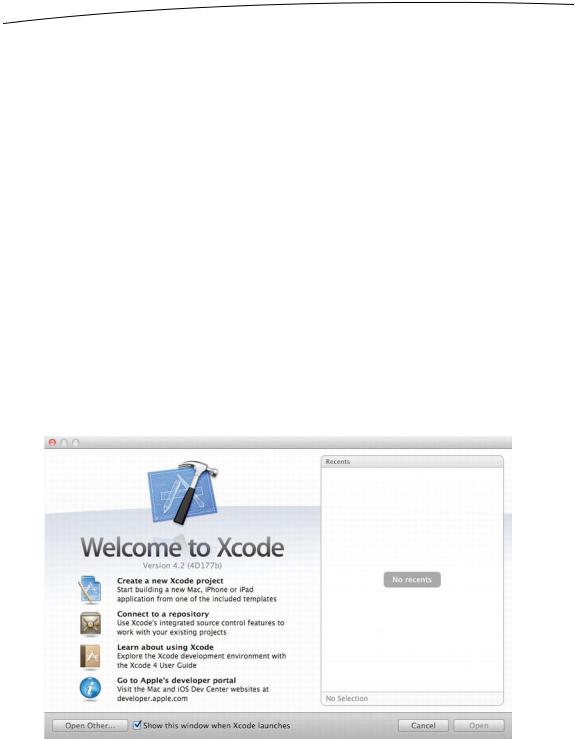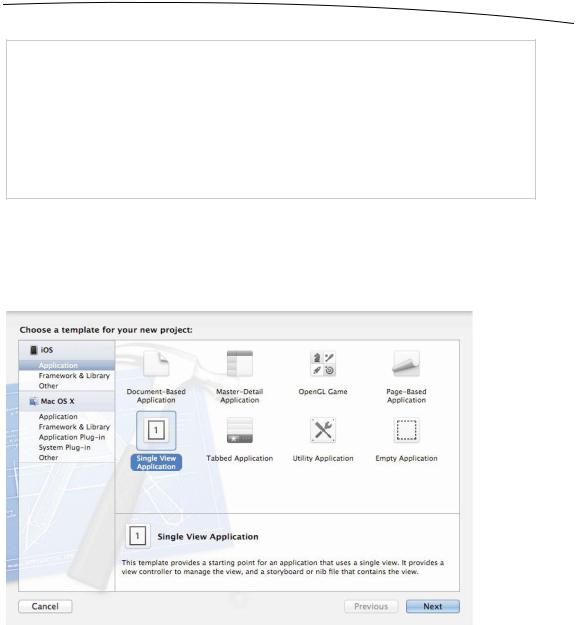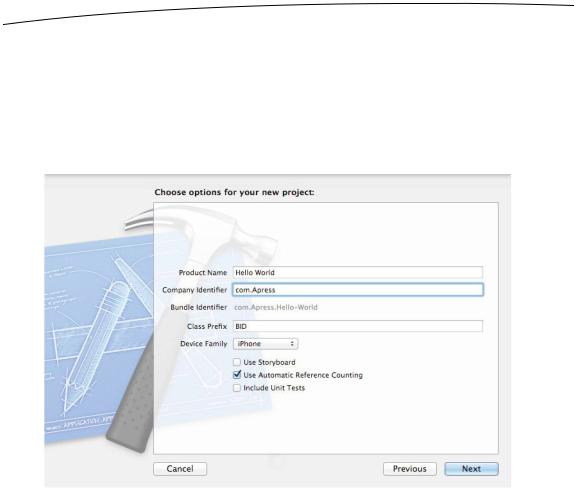
- •Contents at a Glance
- •About the Authors
- •About the Technical Reviewer
- •Acknowledgments
- •Preface
- •What This Book Is
- •What You Need
- •Developer Options
- •What You Need to Know
- •What’s Different About Coding for iOS?
- •Only One Active Application
- •Only One Window
- •Limited Access
- •Limited Response Time
- •Limited Screen Size
- •Limited System Resources
- •No Garbage Collection, but…
- •Some New Stuff
- •A Different Approach
- •What’s in This Book
- •What’s New in This Update?
- •Are You Ready?
- •Setting Up Your Project in Xcode
- •The Xcode Workspace Window
- •The Toolbar
- •The Navigator View
- •The Jump Bar
- •The Utility Pane
- •Interface Builder
- •New Compiler and Debugger
- •A Closer Look at Our Project
- •Introducing Xcode’s Interface Builder
- •What’s in the Nib File?
- •The Library
- •Adding a Label to the View
- •Changing Attributes
- •Some iPhone Polish—Finishing Touches
- •Bring It on Home
- •The Model-View-Controller Paradigm
- •Creating Our Project
- •Looking at the View Controller
- •Understanding Outlets and Actions
- •Outlets
- •Actions
- •Cleaning Up the View Controller
- •Designing the User Interface
- •Adding the Buttons and Action Method
- •Adding the Label and Outlet
- •Writing the Action Method
- •Trying It Out
- •Looking at the Application Delegate
- •Bring It on Home
- •A Screen Full of Controls
- •Active, Static, and Passive Controls
- •Creating the Application
- •Implementing the Image View and Text Fields
- •Adding the Image View
- •Resizing the Image View
- •Setting View Attributes
- •The Mode Attribute
- •Interaction Checkboxes
- •The Alpha Value
- •Background
- •Drawing Checkboxes
- •Stretching
- •Adding the Text Fields
- •Text Field Inspector Settings
- •Setting the Attributes for the Second Text Field
- •Creating and Connecting Outlets
- •Closing the Keyboard
- •Closing the Keyboard When Done Is Tapped
- •Touching the Background to Close the Keyboard
- •Adding the Slider and Label
- •Creating and Connecting the Actions and Outlets
- •Implementing the Action Method
- •Adding Two Labeled Switches
- •Connecting and Creating Outlets and Actions
- •Implementing the Switch Actions
- •Adding the Button
- •Connecting and Creating the Button Outlets and Actions
- •Implementing the Segmented Control Action
- •Implementing the Action Sheet and Alert
- •Conforming to the Action Sheet Delegate Method
- •Showing the Action Sheet
- •Spiffing Up the Button
- •Using the viewDidLoad Method
- •Control States
- •Stretchable Images
- •Crossing the Finish Line
- •The Mechanics of Autorotation
- •Points, Pixels, and the Retina Display
- •Autorotation Approaches
- •Handling Rotation Using Autosize Attributes
- •Configuring Supported Orientations
- •Specifying Rotation Support
- •Designing an Interface with Autosize Attributes
- •Using the Size Inspector’s Autosize Attributes
- •Setting the Buttons’ Autosize Attributes
- •Restructuring a View When Rotated
- •Creating and Connecting Outlets
- •Moving the Buttons on Rotation
- •Swapping Views
- •Designing the Two Views
- •Implementing the Swap
- •Changing Outlet Collections
- •Rotating Out of Here
- •Common Types of Multiview Apps
- •The Architecture of a Multiview Application
- •The Root Controller
- •Anatomy of a Content View
- •Building View Switcher
- •Creating Our View Controller and Nib Files
- •Modifying the App Delegate
- •Modifying BIDSwitchViewController.h
- •Adding a View Controller
- •Building a View with a Toolbar
- •Writing the Root View Controller
- •Implementing the Content Views
- •Animating the Transition
- •Switching Off
- •The Pickers Application
- •Delegates and Data Sources
- •Setting Up the Tab Bar Framework
- •Creating the Files
- •Adding the Root View Controller
- •Creating TabBarController.xib
- •The Initial Test Run
- •Implementing the Date Picker
- •Implementing the Single-Component Picker
- •Declaring Outlets and Actions
- •Building the View
- •Implementing the Controller As a Data Source and Delegate
- •Implementing a Multicomponent Picker
- •Declaring Outlets and Actions
- •Building the View
- •Implementing the Controller
- •Implementing Dependent Components
- •Creating a Simple Game with a Custom Picker
- •Writing the Controller Header File
- •Building the View
- •Adding Image Resources
- •Implementing the Controller
- •The spin Method
- •The viewDidLoad Method
- •Final Details
- •Linking in the Audio Toolbox Framework
- •Final Spin
- •Table View Basics
- •Table Views and Table View Cells
- •Grouped and Plain Tables
- •Implementing a Simple Table
- •Designing the View
- •Writing the Controller
- •Adding an Image
- •Using Table View Cell Styles
- •Setting the Indent Level
- •Handling Row Selection
- •Changing the Font Size and Row Height
- •Customizing Table View Cells
- •Adding Subviews to the Table View Cell
- •Creating a UITableViewCell Subclass
- •Adding New Cells
- •Implementing the Controller’s Code
- •Loading a UITableViewCell from a Nib
- •Designing the Table View Cell in Interface Builder
- •Using the New Table View Cell
- •Grouped and Indexed Sections
- •Building the View
- •Importing the Data
- •Implementing the Controller
- •Adding an Index
- •Implementing a Search Bar
- •Rethinking the Design
- •A Deep Mutable Copy
- •Updating the Controller Header File
- •Modifying the View
- •Modifying the Controller Implementation
- •Copying Data from allNames
- •Implementing the Search
- •Changes to viewDidLoad
- •Changes to Data Source Methods
- •Adding a Table View Delegate Method
- •Adding Search Bar Delegate Methods
- •Adding a Magnifying Glass to the Index
- •Adding the Special Value to the Keys Array
- •Suppressing the Section Header
- •Telling the Table View What to Do
- •Putting It All on the Table
- •Navigation Controller Basics
- •Stacky Goodness
- •A Stack of Controllers
- •Nav, a Hierarchical Application in Six Parts
- •Meet the Subcontrollers
- •The Disclosure Button View
- •The Checklist View
- •The Rows Control View
- •The Movable Rows View
- •The Deletable Rows View
- •The Editable Detail View
- •The Nav Application’s Skeleton
- •Creating the Top-Level View Controller
- •Setting Up the Navigation Controller
- •Adding the Images to the Project
- •First Subcontroller: The Disclosure Button View
- •Creating the Detail View
- •Modifying the Disclosure Button Controller
- •Adding a Disclosure Button Controller Instance
- •Second Subcontroller: The Checklist
- •Creating the Checklist View
- •Adding a Checklist Controller Instance
- •Third Subcontroller: Controls on Table Rows
- •Creating the Row Controls View
- •Adding a Rows Control Controller Instance
- •Fourth Subcontroller: Movable Rows
- •Creating the Movable Row View
- •Adding a Move Me Controller Instance
- •Fifth Subcontroller: Deletable Rows
- •Creating the Deletable Rows View
- •Adding a Delete Me Controller Instance
- •Sixth Subcontroller: An Editable Detail Pane
- •Creating the Data Model Object
- •Creating the Detail View List Controller
- •Creating the Detail View Controller
- •Adding an Editable Detail View Controller Instance
- •But There’s One More Thing. . .
- •Breaking the Tape
- •Creating a Simple Storyboard
- •Dynamic Prototype Cells
- •Dynamic Table Content, Storyboard-Style
- •Editing Prototype Cells
- •Good Old Table View Data Source
- •Will It Load?
- •Static Cells
- •Going Static
- •So Long, Good Old Table View Data Source
- •You Say Segue, I Say Segue
- •Creating Segue Navigator
- •Filling the Blank Slate
- •First Transition
- •A Slightly More Useful Task List
- •Viewing Task Details
- •Make More Segues, Please
- •Passing a Task from the List
- •Handling Task Details
- •Passing Back Details
- •Making the List Receive the Details
- •If Only We Could End with a Smooth Transition
- •Split Views and Popovers
- •Creating a SplitView Project
- •The Storyboard Defines the Structure
- •The Code Defines the Functionality
- •The App Delegate
- •The Master View Controller
- •The Detail View Controller
- •Here Come the Presidents
- •Creating Your Own Popover
- •iPad Wrap-Up
- •Getting to Know Your Settings Bundle
- •The AppSettings Application
- •Creating the Project
- •Working with the Settings Bundle
- •Adding a Settings Bundle to Our Project
- •Setting Up the Property List
- •Adding a Text Field Setting
- •Adding an Application Icon
- •Adding a Secure Text Field Setting
- •Adding a Multivalue Field
- •Adding a Toggle Switch Setting
- •Adding the Slider Setting
- •Adding Icons to the Settings Bundle
- •Adding a Child Settings View
- •Reading Settings in Our Application
- •Retrieving User Settings
- •Creating the Main View
- •Updating the Main View Controller
- •Registering Default Values
- •Changing Defaults from Our Application
- •Keeping It Real
- •Beam Me Up, Scotty
- •Your Application’s Sandbox
- •Getting the Documents Directory
- •Getting the tmp Directory
- •File-Saving Strategies
- •Single-File Persistence
- •Multiple-File Persistence
- •Using Property Lists
- •Property List Serialization
- •The First Version of the Persistence Application
- •Creating the Persistence Project
- •Designing the Persistence Application View
- •Editing the Persistence Classes
- •Archiving Model Objects
- •Conforming to NSCoding
- •Implementing NSCopying
- •Archiving and Unarchiving Data Objects
- •The Archiving Application
- •Implementing the BIDFourLines Class
- •Implementing the BIDViewController Class
- •Using iOS’s Embedded SQLite3
- •Creating or Opening the Database
- •Using Bind Variables
- •The SQLite3 Application
- •Linking to the SQLite3 Library
- •Modifying the Persistence View Controller
- •Using Core Data
- •Entities and Managed Objects
- •Key-Value Coding
- •Putting It All in Context
- •Creating New Managed Objects
- •Retrieving Managed Objects
- •The Core Data Application
- •Designing the Data Model
- •Creating the Persistence View and Controller
- •Persistence Rewarded
- •Managing Document Storage with UIDocument
- •Building TinyPix
- •Creating BIDTinyPixDocument
- •Code Master
- •Initial Storyboarding
- •Creating BIDTinyPixView
- •Storyboard Detailing
- •Adding iCloud Support
- •Creating a Provisioning Profile
- •Enabling iCloud Entitlements
- •How to Query
- •Save Where?
- •Storing Preferences on iCloud
- •What We Didn’t Cover
- •Grand Central Dispatch
- •Introducing SlowWorker
- •Threading Basics
- •Units of Work
- •GCD: Low-Level Queueing
- •Becoming a Blockhead
- •Improving SlowWorker
- •Don’t Forget That Main Thread
- •Giving Some Feedback
- •Concurrent Blocks
- •Background Processing
- •Application Life Cycle
- •State-Change Notifications
- •Creating State Lab
- •Exploring Execution States
- •Making Use of Execution State Changes
- •Handling the Inactive State
- •Handling the Background State
- •Removing Resources When Entering the Background
- •Saving State When Entering the Background
- •A Brief Journey to Yesteryear
- •Back to the Background
- •Requesting More Backgrounding Time
- •Grand Central Dispatch, Over and Out
- •Two Views of a Graphical World
- •The Quartz 2D Approach to Drawing
- •Quartz 2D’s Graphics Contexts
- •The Coordinate System
- •Specifying Colors
- •A Bit of Color Theory for Your iOS Device’s Display
- •Other Color Models
- •Color Convenience Methods
- •Drawing Images in Context
- •Drawing Shapes: Polygons, Lines, and Curves
- •The QuartzFun Application
- •Setting Up the QuartzFun Application
- •Creating a Random Color
- •Defining Application Constants
- •Implementing the QuartzFunView Skeleton
- •Creating and Connecting Outlets and Actions
- •Implementing the Action Methods
- •Adding Quartz 2D Drawing Code
- •Drawing the Line
- •Drawing the Rectangle and Ellipse
- •Drawing the Image
- •Optimizing the QuartzFun Application
- •The GLFun Application
- •Setting Up the GLFun Application
- •Creating BIDGLFunView
- •Updating BIDViewController
- •Updating the Nib
- •Finishing GLFun
- •Drawing to a Close
- •Multitouch Terminology
- •The Responder Chain
- •Responding to Events
- •Forwarding an Event: Keeping the Responder Chain Alive
- •The Multitouch Architecture
- •The Four Touch Notification Methods
- •The TouchExplorer Application
- •The Swipes Application
- •Automatic Gesture Recognition
- •Implementing Multiple Swipes
- •Detecting Multiple Taps
- •Detecting Pinches
- •Defining Custom Gestures
- •The CheckPlease Application
- •The CheckPlease Touch Methods
- •Garçon? Check, Please!
- •The Location Manager
- •Setting the Desired Accuracy
- •Setting the Distance Filter
- •Starting the Location Manager
- •Using the Location Manager Wisely
- •The Location Manager Delegate
- •Getting Location Updates
- •Getting Latitude and Longitude Using CLLocation
- •Error Notifications
- •Trying Out Core Location
- •Updating Location Manager
- •Determining Distance Traveled
- •Wherever You Go, There You Are
- •Accelerometer Physics
- •Don’t Forget Rotation
- •Core Motion and the Motion Manager
- •Event-Based Motion
- •Proactive Motion Access
- •Accelerometer Results
- •Detecting Shakes
- •Baked-In Shaking
- •Shake and Break
- •Accelerometer As Directional Controller
- •Rolling Marbles
- •Writing the Ball View
- •Calculating Ball Movement
- •Rolling On
- •Using the Image Picker and UIImagePickerController
- •Implementing the Image Picker Controller Delegate
- •Road Testing the Camera and Library
- •Designing the Interface
- •Implementing the Camera View Controller
- •It’s a Snap!
- •Localization Architecture
- •Strings Files
- •What’s in a Strings File?
- •The Localized String Macro
- •Real-World iOS: Localizing Your Application
- •Setting Up LocalizeMe
- •Trying Out LocalizeMe
- •Localizing the Nib
- •Localizing an Image
- •Generating and Localizing a Strings File
- •Localizing the App Display Name
- •Auf Wiedersehen
- •Apple’s Documentation
- •Mailing Lists
- •Discussion Forums
- •Web Sites
- •Blogs
- •Conferences
- •Follow the Authors
- •Farewell
- •Index

Chapter 2
Appeasing the Tiki Gods
As you’re probably well aware, it has become something of a tradition to call the first project in any book on programming “Hello, World.” We considered breaking this tradition, but were scared that the tiki gods would inflict some painful retribution on us for such a gross breach of etiquette. So, let’s do it by the book, shall we?
In this chapter, we’re going to use Xcode to create a small iOS application that will display the text “Hello, World!” We’ll look at what’s involved in creating an iOS application project in Xcode, work through the specifics of using Xcode’s Interface Builder to design our application’s user interface, and then run our application on the iOS simulator. After that, we’ll give our application an icon to make it feel more like a real iOS application.
We have a lot to do here, so let’s get going.
Setting Up Your Project in Xcode
By now, you should have Xcode and the iOS SDK installed on your machine. You should also download the book project archive from the book web site (http://www.iphonedevbook.com/forum/forum.php). The book forums are a great place to download the latest book source code, get your questions answered, and meet up with like-minded people. Of course, you can also find the source code on the Apress web site.
NOTE: Even though you have the complete set of project files at your disposal in this book’s
project archive, you’ll get more out of the book if you create each project by hand, rather than simply running the version you downloaded. By doing that, you’ll gain familiarity and expertise working with the various application development tools.
There’s no substitute for actually creating applications; software development is not a spectator
sport.
D.Mark et al., Beginning iOS 5 Development
©Dave Mark, Jack Nutting, Jeff LaMarche 2011
www.it-ebooks.info

14 |
CHAPTER 2: Appeasing the Tiki Gods |
The project we’re going to build in this chapter is contained in the 02 Hello World folder of the project archive.
Before we can start, we need to launch Xcode. Xcode is the tool that we’ll use to do most of what we do in this book, but it’s not installed in the /Applications folder as with most Mac applications. If you’ve already installed the developer tools as outlined in the previous chapter, you’ll find Xcode located in /Developer/Applications. You’ll be using Xcode a lot, so you might want to consider dragging it to your dock so you’ll have ready access to it.
If this is your first time using Xcode, don’t worry; we’ll walk you through every step involved in creating a new project. Apple recently released a new, completely rewritten version of Xcode that’s quite a bit different than the previous version. If you’re already an old hand but haven’t worked with Xcode 4, you will find that quite a bit has changed.
When you first launch Xcode, you’ll be presented with a welcome window like the one shown in Figure 2–1. From here, you can choose to create a new project, connect to a version-control system to check out an existing project, or select from a list of recently opened projects. The welcome window also contains links to iOS and Mac OS X technical documentation, tutorial videos, news, sample code, and other useful items. All of this functionality can be accessed from the Xcode menu as well, but this window gives you a nice starting point, covering some of the most common tasks you’re likely to want to do after launching Xcode. If you feel like poking through the information here for a few minutes, by all means, go right ahead. When you’re finished, close the window, and we’ll proceed. If you would rather not see this window in the future, just uncheck the
Show this window when Xcode launches checkbox before closing it.
Figure 2–1. The Xcode welcome window
www.it-ebooks.info

CHAPTER 2: Appeasing the Tiki Gods |
15 |
NOTE: If you have an iPhone, iPad, or iPod touch connected to your machine, you might see a message when you first launch Xcode asking whether you want to use that device for development. For now, click the Ignore button. Alternatively, the Organizer window, which shows
(among other things) the devices that have been synchronized with your computer, might appear. In that case, just close the Organizer window. If you choose to join the paid iOS Developer Program, you will gain access to a program portal that will tell you how to use your iOS device for
development and testing.
Create a new project by selecting New New Project... from the File menu (or by pressingN). A new project window will open, and will show you the project template selection sheet (see Figure 2–2). From this sheet, you’ll choose a project template to use as a starting point for building your application. The pane on the left side of the sheet is divided into two main sections: iOS and Mac OS X. Since we’re building an iOS application, select Application in the iOS section to reveal the iOS application templates.
Figure 2–2. The project template selection sheet lets you select from various templates when creating a new project.
Each of the icons shown in the upper-right pane in Figure 2–2 represents a separate project template that can be used as a starting point for your iOS applications. The icon labeled Single View Application is the simplest template and the one we’ll be using for the first several chapters. The other templates provide additional code and/or resources needed to create common iPhone and iPad application interfaces, as you’ll see in later chapters.
www.it-ebooks.info

16 CHAPTER 2: Appeasing the Tiki Gods
Click the Single View Application icon (as in Figure 2–2), and then click the Next button. You’ll see the project options sheet, which should look like Figure 2–3. On this sheet, you need to specify the Product Name and Company Identifier for your project. Xcode will combine the two of those to generate a unique Bundle Identifier for your app. Name your product Hello World, and then enter com.apress in the Company Identifier field, as shown in Figure 2–3. Later, after you’ve signed up for the developer program and learned about provisioning profiles, you’ll want to use your own company identifier. We’ll talk more about the bundle identifier later in the chapter.
Figure 2–3. Selecting a product name and company identifier for your project. Use these settings for now.
The next text box is labeled Class Prefix, and we should populate this with a sequence of at least three capital letters. These characters will be added to the beginning of the name of all classes that Xcode creates for us. This is done to avoid naming conflicts with Apple (who reserves the use of all two-letter prefixes) and other developers whose code we might use. In Objective-C, having more than one class with the same name will prevent your application from being built.
For the projects in the book, we’re going to use the prefix BID, which stands for Beginning iPhone Development. While there are likely to be many classes named, for example, ViewController, far fewer classes are likely to be named BIDMyViewController, which means a lot less chance of conflicts.
We also need to specify the Device Family. In other words, Xcode wants to know if we’re building an app for the iPhone and iPod touch, if we’re building an app for the iPad, or if we’re building a universal application that will run on all iOS devices. Select iPhone for the Device Family if it’s not already selected. This tells Xcode that we’ll be targeting this particular app at the iPhone and iPod touch, which have the same screen size. For the
www.it-ebooks.info

CHAPTER 2: Appeasing the Tiki Gods |
17 |
first part of the book, we’ll be using the iPhone device family, but don’t worry—we’ll cover the iPad also.
There are three checkboxes on this sheet. You should check the middle option, Use Automatic Reference Counting, but uncheck the other two. Automatic Reference Counting (ARC) is a new feature of the Objective-C language, introduced with iOS 5, that makes your life much easier. We’ll talk briefly about ARC in the next chapter.
The Use Storyboard option will be covered starting in Chapter 10. The other option— Include Unit Tests—will set up your project in such a way that you can add special pieces of code to your project, called unit tests, which are not part of your application, but run every time you create your application to test certain functionality. Unit tests allow you to identify when a change made to your code breaks something that was previously working. Although it can be a valuable tool, we won’t be using automated unit testing in this book, so you can leave its box unchecked.
Click Next again, and you’ll be asked where to save your new project using a standard save sheet, as shown in Figure 2–4. If you haven’t already done so, jump over to the Finder and create a new master directory for these book projects, and then return to Xcode and navigate into that directory. Before you click the Create button, be sure to uncheck the Create local git repository for this project checkbox. With the Source Control checkbox unchecked, create the new project by clicking the Create button.
NOTE: A source control repository is a tool used to keep track of changes made to an application’s source code and resources while it’s being built. It also facilitates multiple
developers working on the same application at the same time by providing tools to resolve conflicts when they arise. We won’t be using source control in this book, so you can leave its box
unchecked.
www.it-ebooks.info
